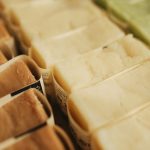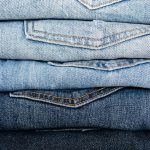You’ll notice woven fabric is made by interlacing yarns at right angles, giving it strength, durability, and shape retention—perfect for clothing or upholstery. Nonwoven fabric forms by bonding fibers quickly without weaving, making it soft, flexible, and cost-effective but less strong. While wovens last longer, nonwovens suit disposables and medical uses. Understanding these differences can help you pick the right fabric for your needs, and there’s more to explore about their unique features and impact.
Table of Contents
Key Takeaways
- Woven fabrics are made by interlacing yarns at right angles, creating a stable, durable structure.
- Nonwoven fabrics are formed by bonding or felting fibers without weaving, allowing quick and versatile production.
- Woven fabrics offer higher strength and resistance to tearing compared to the softer, less durable nonwovens.
- Woven fabrics are ideal for long-lasting uses like clothing and upholstery; nonwovens suit disposable or lightweight products.
- Woven fabric production uses more resources, while nonwovens are faster to produce but often rely on synthetic fibers.
Understanding Woven Fabric: Structure and Characteristics
Although woven fabric has been around for centuries, you mightn’t realize how its unique structure influences its strength and durability.
When you look closely, woven fabric consists of two sets of yarns interlaced at right angles: the warp runs lengthwise, while the weft crosses it horizontally. This tight, perpendicular arrangement gives woven fabric its stability and resistance to stretching.
You’ll find that the weave pattern — plain, twill, or satin — affects both the fabric’s texture and flexibility. Because of this construction, woven fabrics hold their shape well and tend to be strong, making them ideal for clothing, upholstery, and other applications where durability matters.
When you choose woven fabric, you’re selecting a material designed for lasting performance thanks to its thoughtful interlacing.
Exploring Nonwoven Fabric: Formation and Uses
Since nonwoven fabrics don’t rely on weaving or knitting, they form through bonding or felting fibers together using heat, chemicals, or pressure. You’ll find nonwovens in a range of applications thanks to their versatility and cost-effectiveness. They’re common in medical supplies, filters, and disposable hygiene products. Their structure allows for quick production and customization.
| Formation Method | Key Feature | Common Use |
|---|---|---|
| Thermal Bonding | Heat fuses fibers | Medical masks |
| Chemical Bonding | Adhesives hold fibers | Wipes and filters |
| Mechanical Felting | Fibers entangle | Insulation materials |
Comparing Durability and Strength of Woven Vs Nonwoven
When you compare woven and nonwoven fabrics, you’ll notice that woven fabrics generally offer greater durability and strength because their interlaced fibers create a tight, stable structure.
This interlacing resists tearing and stretching, making woven fabrics ideal when you need long-lasting material.
Nonwoven fabrics, on the other hand, consist of fibers bonded together by heat, chemicals, or pressure, which typically results in lower tensile strength.
While some nonwovens can be engineered for decent durability, they usually don’t match the robustness of woven fabrics.
However, nonwovens excel in flexibility and softness but tend to wear out faster under heavy use.
Applications Best Suited for Woven and Nonwoven Fabrics
Because woven and nonwoven fabrics have distinct properties, they suit different applications depending on your needs.
If you need strength and durability, woven fabrics are ideal for clothing, upholstery, and industrial uses. Their tightly interlaced fibers give you long-lasting performance and a polished look.
Woven fabrics offer strength, durability, and a polished look, perfect for clothing and industrial applications.
On the other hand, nonwoven fabrics excel when you require disposable or lightweight materials. You’ll find them in medical supplies, hygiene products, and filtration systems where quick production and functionality matter most.
When choosing between these fabrics, consider whether you prioritize reusability and strength or convenience and cost-efficiency.
Environmental Impact and Sustainability Considerations
Although woven and nonwoven fabrics serve different purposes, their environmental impact plays a crucial role in your choice.
Woven fabrics often require more water and energy during production due to the weaving process and finishing treatments. On the other hand, nonwoven fabrics usually have a faster, less resource-intensive manufacturing method, but many rely on synthetic fibers, which aren’t biodegradable and can contribute to microplastic pollution.
If sustainability matters to you, look for woven fabrics made from organic or recycled fibers. For nonwovens, seek out options using natural fibers or those designed for recyclability.
Ultimately, understanding the lifecycle—from raw materials to disposal—helps you pick fabrics that align with your environmental values while meeting your functional needs.
Frequently Asked Questions
How Do Washing and Care Differ for Woven Vs Nonwoven Fabrics?
When it comes to washing, you’ll want to treat woven fabrics like a delicate dance—gentle cycles and mild detergents. Nonwoven fabrics need extra care since they can fall apart easily, so avoid heavy agitation or high heat.
Can Woven and Nonwoven Fabrics Be Combined in a Single Product?
Yes, you can combine woven and nonwoven fabrics in one product. Doing so lets you enjoy the strength of woven fabric and the versatility of nonwoven material, creating functional and innovative textile solutions tailored to your needs.
What Are the Cost Differences in Manufacturing Woven and Nonwoven Fabrics?
Imagine weaving gold threads versus spinning quicksilver; woven fabrics cost more due to labor and time, while nonwovens are cheaper, made faster with less skill—so you save money but trade off durability and texture.
How Do Woven and Nonwoven Fabrics Perform in Extreme Weather?
You’ll find woven fabrics generally handle extreme weather better, offering durability and breathability. Nonwoven fabrics might struggle with moisture and heat but provide excellent insulation and resistance to chemicals, depending on their material and treatment.
Are There Any Health Concerns Related to Nonwoven Fabric Materials?
You might worry about chemicals or fibers in nonwoven fabrics causing irritation or allergies. However, most are safe if certified. Always check labels and avoid prolonged skin contact if you have sensitive skin or respiratory issues.
- Does Chiffon Fabric Stink - July 15, 2025
- Does Chiffon Fabric Affect the Economy - July 15, 2025
- Does Cotton Fabric Have a Nap - July 15, 2025







